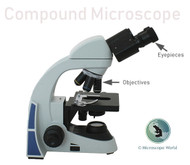What is a Compound Microscope?
Apr 8th 2019
A compound microscope is often referred to as a biological microscope, but is a compound microscope always a biological microscope? You might be surprised at the answer. Read more to learn all about compound microscopes and their uses.
The Parts & Function of a Compound Microscope
A compound microscope is a high power (high magnification) microscope that uses a compound lens system. A compound microscope has multiple lenses: the objective lens (typically 4x, 10x, 40x or 100x) is compounded (multiplied) by the eyepiece lens (typically 10x) to obtain a high magnification of 40x, 100x, 400x and 1000x. Higher magnification is achieved by using two lenses rather than just a single magnifying lens. While the eyepieces and the objective lenses create high magnification, a condenser beneath the stage focuses the light directly into the sample.

What is a Compound Microscope Used For?
Most people think of a biological microscope when they hear the term compound microscope. This is true that a biological microscope is a compound microscope. But there are some other types of compound microscopes as well. A biological microscope may also be referred to as a brightfield or transmitted light microscope.
A phase contrast microscope is a compound microscope that utilizes a special phase contrast objective lens and a phase slider or phase condenser to bring out contrast in a sample without having to stain the sample. Phase contrast microscopes are used to look at bacteria or blood cells. You can learn more about phase contrast here.
A polarizing microscope is another type of compound microscope. Polarizing microscopes use both an analyzer and polarizer to cross-polarize the light and pick up differences in the colors in the optical path of the specimen being examined. Polarizing compound microscopes are used to examine chemicals in the pharmaceutical industry and petrologists and geologists use polarizing microscopes to examine minerals and thin slices of rocks.
A metallurgical microscope is a compound microscope that may have transmitted and reflected light, or just reflected light. This reflected light shines down through the objective lens. Metallurgical compound microscopes are specifically used in industrial settings to view samples at high magnification (such as metals) that will not allow light to pass through them. Metallurgical microscopes may also utilize darkfield microscopy, which is a specific technique that back-illuminates a sample in order to highlight specific features of the sample such as hairline metal fractures or flaws in precious stones.
Fluorescence microscopes and DIC (differential interference contrast) are other types of compound microscopes. These are biological microscopes that use different light wavelengths to fluoresce a sample in order to study the specimen.
Compound Microscope Magnification
A compound microscope is an upright microscope that uses two sets of lenses (a compound lens system) to obtain higher magnification than a stereo microscope. A compound microscope provides a two-dimensional image, while a stereo microscope provides a three-dimensional image. Compound microscopes typically provide magnification in the range of 40x-1000x, while a stereo microscope will provide magnification of 10x-40x. Compound microscopes are used to view small samples that can not be identified with the naked eye. These samples are typically placed on a slide under the microscope. When using a stereo microscope, there is more room under the microscope for larger samples such as rocks or flowers and slides are not required.

You can view the parts of the compound microscope here, or download an activity worksheet where you can label the parts of the microscope here.
If you have any questions about compound microscopes contact Microscope World.





